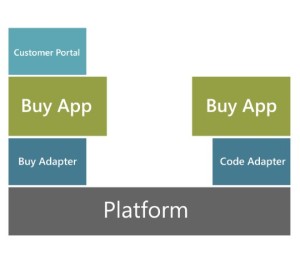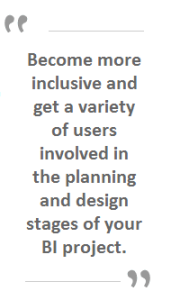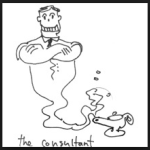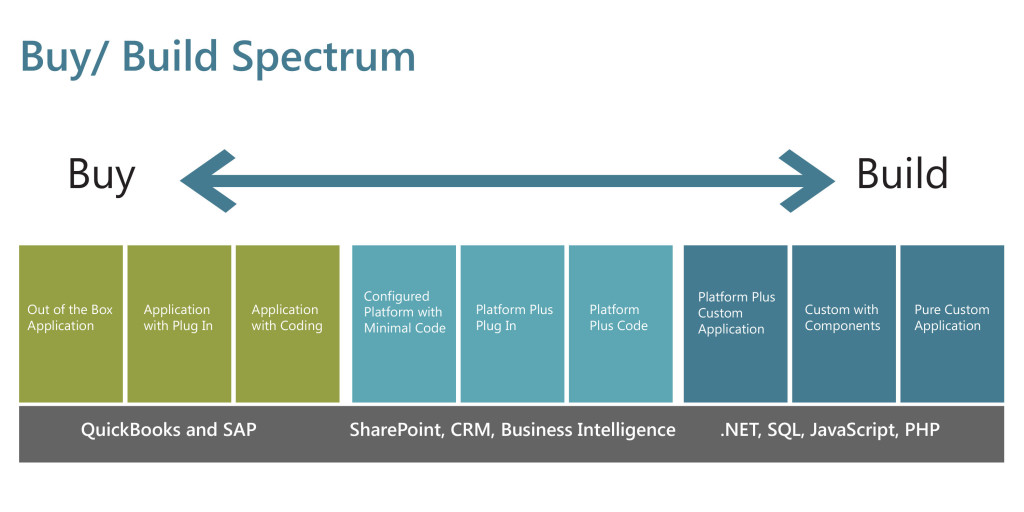Components of a Business Intelligence Solution
There are many different technical frameworks available for implementing a business intelligence solution, all offered by a variety of vendors. In a general sense though, there are three overarching pieces to business intelligence:
- Integration and the data warehouse
- Data cubes and analytics
- Dashboards, KPI’s and reports
Understanding these pieces and how they work in tandem to address organizational needs is critical in software consulting to achieve a successful implementation. I will be covering one each week for the next few weeks, starting with integration and the data warehouse.
InfoPath Retirement: The Doctor is In
SharePoint Consulting Prescribes Solutions to Fit Your Business
SharePoint consulting is often not unlike being a doctor. When a patient visits their doctor, she doesn’t assume that penicillin is the fix for everyone who walks in the door. Instead, a cure is recommended based on specific symptoms.
The same goes for our customers. When we first engage with a new company, the SharePoint team spends some time understanding how the business process is lacking. We’ll also ask questions about specific business goals, long term plans, the number of users, and more. Read More
SharePoint Consulting: Solutions to Common BCS Errors
Solving BCS Errors with SharePoint Consulting
My recent SharePoint consulting work has involved working through a few BCS errors. Programmatically accessing BCS External Lists in SharePoint is a bit like working in a parallel universe. Most list access rules will continue to apply, however there are some very special caveats that one must remember.
For the reader’s findability convenience, I am organizing this guide in terms of the errors that the user will most likely encounter. Read More
Enterprise Content Management: Azure Blob Storage
Collaboration and Enterprise Content Management
Enterprise content management can be a big pain point for organizations that do not properly plan ahead for file sharing. One Entrance client had an interesting problem that the software consulting team was asked to fix. Read More
Business Intelligence: What is Hadoop?
Hadoop: The New Face of Business Intelligence
Big data has changed the way businesses handle their business intelligence initiatives, requiring them to capture, process, and analyze exponentially larger amounts of information. Traditional business intelligence tools like relational databases are no longer sufficient to handle the level of data businesses are experiencing.
If businesses are going to take advantage of the insights offered by big data—instead of drowning in the flood of useless and irrelevant data—they are going to need new tools to help them handle the data crush. Read More
SharePoint Consulting: Workflow Strategy
SharePoint Consulting and Automation
SharePoint consulting can be the time saver that your team has been looking for. Automation, what a wonderful thing! We have become very accustomed to the most mundane tasks taking care of themselves.
Consider the washing machine, the dishwasher, cruise control, the thermostat in your house, and everyone’s favorite, automated phone menu systems! Computing and automation goes hand-in-hand. Read More
Data Management: Measuring Quality
Data Management for Upstream
In the world of data management, there are two factors that are important to account for: quality and access.
Measuring data quality was the topic of a PPDM presentation by Jeremy Eade, a Subsurface Data Lead at BP. His approach to data management specifically surrounded the consistency of data surrounding wells. Read More
Entrance Custom Software Consultants See Doubled Growth in 2013
A Growing Team of Custom Software Consultants
2013 was a landmark year for the Entrance custom software team. Some of the business accomplishments included:
- Doubling headcount
- Increasing revenue by 50%
- Increasing work capacity by 50%
- Addition of several high profile Upstream clients
- Grew the already substantial footprint of oil and gas service company clients
A Bigger Office to Match
As the Entrance team has grown, so too has the need for office space. As a result, the footprint of the business has nearly doubled as well.Many new consultants have taken their place in what the team calls the bullpen.
Desks and cube walls can be moved around at will in this new space. This is meant to enable project teams to work together flexibly and collaboratively.
Most employees can agree that the best part of the phase two expansion is the addition of the Fishbowl. The Fishbowl features a ping-pong table, shuffle board, golf practice areas, and a soda machine, with more fun additions to come.
Company growth is projected to continue at similar rates. As a result, planning has already begun for phase three of the office expansion!
Great Managers for Great Teams
A growing company also demonstrates the need for more managers. In the past six months, Entrance has hired a new HR manager, a sales manager, and four new project managers.
As a result, the team can now benefit from several new skill-sets, like energy warehousing.
The need to keep employees while aggressively hiring new ones has also led to an expansion in fringe benefits. Entrance team members now enjoy a fitness room, locker room, fully stocked smoothie station, gym memberships, and healthy snack options.
Strategy to Lead the Way Forward
While every successful company relies on a little luck, a good CEO will tell you that the strategy behind explosive growth has to be sound. As such, the Entrance management team rolled out a new three year strategic plan in the second half of 2013.
In addition, the team has also developed a new 25 year vision for Entrance to become the world authority on software for the energy industry.
As Entrance closes the chapter on its first decade, the entire company looks towards even bigger and better things in the next ten years.
Said Entrance president Nate Richards, ” It’s exciting to celebrate a decade of successful business! Our success so far really feels like the beginning of the next chapter.”
For more on the growing Entrance team, read this post about quarterly goal celebrations!
Custom Software: Four Moments of Truth
Moments of Truth for Custom Software
During a recent leadership conference the Entrance team began brainstorming how to make our custom software consulting even better. The leadership team has since started an active conversation among our consultant team on this topic.
One of the main points the speaker made was that every business has moments of truth that make all the  difference. For a restaurant, great food and service can be destroyed by a dirty floor or cockroaches. For a clothing store, the most stylish dresses can’t be outweighed by long lines and unfriendly clerks.
difference. For a restaurant, great food and service can be destroyed by a dirty floor or cockroaches. For a clothing store, the most stylish dresses can’t be outweighed by long lines and unfriendly clerks.
One of the Entrance values is “Improve everything,” or as some of us say, “Suck less every day.” As apotential client you may be wondering how we live out this value.
We see moments of truth as one huge opportunity to bring this value front and center. The below is directly from the Entrance custom software team themselves. We see this list as just a few of the places that we strive to improve the quality of our work every day!
Four Moments of Truth in Software
- Any sprint demo
This is the first chance that clients have to see how the Agile methodology works. This isn’t just about selling an idea. It has to meet our client’s needs and efficiently deliver software that works.
- Fixing custom software bugs
Every custom software application gets bugs once in a while. A good development team will identify the problem and fix it as quickly as possible. It’s just not acceptable to say a bug is fixed if it isn’t.
- Owning mistakes
By the same token, every team makes mistakes. It’s how that team owns up to them and makes it better that defines this moment of truth.
For one client, the developer communicated to the client about his mistake. He then quickly fixed it. As a result, the client appreciated his work even more than they would have if there had been no mistake at all!
- Requirements sign-off
This is one of those steps near the end of the custom software process that can make all the difference in terms of satisfaction. The development team and the client sit down to review what was promised and what has been delivered.
This can help bring to the surface any gaps in the final deliverable. If any are discovered, the team can develop a plan for making it right.
Improve Everything with Custom Software
Improving everything is a value that the Entrance team must live out every day. In addition, all of these moments of truth involve a degree of transparency.
As a client, it’s your job clear about what you need and to stay engaged through the process. The result of transparency on Entrance’s side is that you always know where your project is and how we’re delivering on your business need.
For more on quality custom software check out our Agile series, “Getting the Most for Your Money.”
Oil and Gas Software: IT is Adapting in a Brave New World
Oil and gas software helps support IT transformation into valued business partner
It’s no secret that the exploration, drilling and production industry is not the same industry it once was, and oil and gas software can provide companies with the new  capabilities they need to respond to the increasingly competitive environment around them. In a recent article from The American Oil & Gas Reporter, titled “IT Leaders Embrace Challenging Transformation In Upstream Operations”, Johnathan Zanger and Gerry Swift discuss how change in the oil and gas industry has created both challenge and opportunity for IT.
capabilities they need to respond to the increasingly competitive environment around them. In a recent article from The American Oil & Gas Reporter, titled “IT Leaders Embrace Challenging Transformation In Upstream Operations”, Johnathan Zanger and Gerry Swift discuss how change in the oil and gas industry has created both challenge and opportunity for IT.
Zanger and Swift argue that oil and gas companies have a choice: they can either look at IT as a necessary but inconvenient utility—that is, they could continue to look at IT the same way they always have—or, they can start looking at IT as a valued partner that can help meet desired business outcomes.
Decision Making and IT
Zanger and Swift analyzed data provided by seven different exploration, drilling and production IT groups to gain a better understanding of how decisions are being made in these organizations, and how these decisions affect the business. The results of the analysis show a number of ways that growing the partnership between IT and line of business can benefit oil and gas companies:
- Improved data management
- Greater customer satisfaction
- More opportunities to innovate
- More well-defined corporate structure
Improved data management
As oil and gas companies change the way they operate, they must also change the way they capture, analyze and apply data. It’s no longer sufficient to gather data just for the sake of gathering data. Successful companies must be able to capture pertinent data that can be directly applied to business operations. Oil and gas software can provide the data management capabilities needed to make this happen.
Greater customer satisfaction
Ensuring customer satisfaction has long been one of the most important objectives of oil and gas IT organizations. However, changes in the oil and gas industry have also altered the meaning of the term “customer satisfaction.” It’s no longer just a matter of meeting business objectives and focusing on customer needs. IT organizations now need to make themselves truly customer-centric, aligning themselves to provide business value, before the customer even has to ask.
More opportunities to innovate
The importance of innovation in the oil and gas industry is well established. What seems to be less clear is the difference between change and innovation. Innovation constitutes a change for the better, that opens a new and more effective way of doing things. Many oil and gas companies have difficulty identifying innovation opportunities, but Zanger and Swift predict that a greater partnership between business and IT would make these opportunities easier to find.
More well-defined corporate structure
In order for IT to support the business effectively, there must be established processes in place to show the alignments and accountabilities of everyone involved with the IT organization. IT organizations can no longer continue to exist in their own little world. In order for IT organization to provide true business value, they must understand their relationship with the business, and be able to collaborate consistently.
One of the key misconceptions that Zanger and Swift try to do away with in their article is that changing IT requires bleeding-edge technological solutions. In reality, the solutions needed to drive greater IT involvement with business processes already exist, and they’re already proven. IT just needs to find new ways to apply these tools, such as oil and gas software, to support their mission.
For more on this topic, read this article on how the IT service model is changing…
Software Selection: Assessing Your Options on the Market
Software Selection and Available Product Offerings
In this software selection series, I have covered how to assess the need for custom software in addition to business drivers. In this third post, I’d like to spend some time covering how to answer a specific question. What percentage of my needs are addressed by available product offerings?
It can be a very obvious choice to go for an off-the-shelf product. You don’t need to hire or manage a custom software team. In addition, the costs for a software product that already exists are often more clear.
Custom software projects can stretch out over many months or even years. Depending on the quality of your team, the end product may not even be what you bargained for.
Existing Software Platforms
 Buying an existing product is no guarantee that you are purchasing all the functionality that your business requires. In the illustration to the right, you can see an example of a platform. This platform provides the baseline of functionality, with applications and a portal bolted on.
Buying an existing product is no guarantee that you are purchasing all the functionality that your business requires. In the illustration to the right, you can see an example of a platform. This platform provides the baseline of functionality, with applications and a portal bolted on.
Many customers come to Entrance and say, “We’re spending $100,000 a year on SharePoint and we’re getting no ROI. What gives?”
What we tell them is that SharePoint only provides the toolbox. Your company needs to be prepared to make the further investment in customization and workflow in order to prove out the true business value of this platform.
The same is the case for many platforms. Before you make the investment in expensive software tools like these, a team that understands your business needs, budget, and resources should make a full evaluation.
When Software is Too Much
By the same token, there will also be times when a given software tool is way overpowered for your company or department’s needs. In this case, it would be a waste of money and resources to buy SAP if only one report was needed.
Doing a full evaluation of the available products in the market for your industry will help your company to see where a simpler option might fit the need very well. This will save your team and the IT staff the time for and money for investing where a larger business problem exists.
For more on the process of software selection, check out this case study for an oil and gas services company!
Bad Software Consulting: Offshore Voicemails Part 1
Software Consulting that Works for Your Business
There are a lot of bad software consulting vendors out there. Let’s face it, lots of people can write code. But the ability to understand your business needs and execute effectively is another story!
If your company is looking for a software consulting company, it’s important to consider a number of factors, such as:
- Do they know your industry?
Clients come to us all the time saying about their previous software consultant, “They were OK, but they didn’t understand oil and gas.” - Do they understand good UI (user interface)?
There is software, and then there is software that is easy to use and navigate. Not every developer has the skills to accomplish this. - Do they off-shore?
Off-shoring always sounds cheaper from the get-go, but take into account factors like language barriers, different time zones, and a lack of understanding how an American business is run. All of these together can add up to software that is confusing, over budget, or never completed.
We get calls all the time from off-shore telemarketers asking us to outsource our development work. Whose hands do you want to leave the success of your software project in?
For more, check out our post on the “Top Five Signs of Bad Software.”
Data Management Problems: Data Cleansing
Data Management and Quality
Many processes in data management affect the quality of data in a database. These processes may be classified into three categories, such as processes that add new data to the database and those that manipulate existing data in the database.
The remaining category includes processes such as data cleansing that reduce the accuracy of the data over time without actually changing the data. This loss of accuracy is typically the result of changes in the real world that isn’t captured by the database’s collection processes.
Arkady Maydanchik describes the issue of data cleansing in the first chapter of his book Data Quality Assessment.
Cleansing in Data Management
 Data cleansing is becoming increasingly common as more organizations incorporate this process into their data management policies. Traditional data cleansing is a relatively safe process since it’s performed manually, meaning that a staff member must review the data before making any corrections.
Data cleansing is becoming increasingly common as more organizations incorporate this process into their data management policies. Traditional data cleansing is a relatively safe process since it’s performed manually, meaning that a staff member must review the data before making any corrections.
However, modern data cleansing techniques generally involve automatically making corrections to the data based on a set of rules. This rules-driven approach makes corrections more quickly than a manual process, but it also increases the risk of introducing inaccurate data since an automated process affects more records.
Computer programs often implement these rules, which represent an additional source of data inaccuracy since these programs may have their own bugs that can affect data cleansing.
Problems with Data Cleansing
Part of the risk of automatic data cleansing is due to the complexity of the rules in a typical data management environment, which frequently fail to reflect the organization’s actual data requirements. The data may still be incorrect after executing the data-cleansing process, even when it complies with the theoretical data model. The complexity and unrelated nature of many problems with data quality may result in the creation of additional problems in related data elements after performing data cleansing.
For example, employee data includes attributes that are closely related such as employment history, pay history and position history. Correcting one of these attributes is likely to make it inconsistent with the other employment data attributes.
Another factor that contributes to the problems with modern data cleansing is the complacency that data management personnel often exhibit after implementing this process. The combination of these factors often means that data cleansing creates more problems than it solves.
Case Study
The following case study from Maydanchik’s book illustrates the risk of data cleansing, which involved a large corporation with over 15,000 employees and a history of acquiring other businesses. This client needed to cleanse the employment history in its human resources system, primarily due to the large number of incorrect or missing hire dates for its employees.
These inaccuracies were a significant problem because the hire date was used to calculate retirement benefits for the client’s employees. Several sources of legacy data were available, allowing for the creation of several algorithms to cleanse the employment data.
However, many of these employees were hired by an acquired business rather than directly hired by the client corporation. The calculation of the retirement benefits was supposed to be based on the date that the client acquired the employee instead of the employee’s original hire date, but the original data specifications didn’t reflect this business requirement.
This discrepancy caused the data-cleansing process to apply many changes incorrectly. Fortunately, this process also produced a complete audit trail of the changes, which allowed the data analyst to correct these inconsistencies without too much difficulty.
This data-cleansing project was completed satisfactorily in a relatively short period of time, but many such projects create errors that remain in the database for years.
For more on solving data management issues, check out this post on managing data entry.
Four Reasons to Consider Software Consulting
Software Consulting and the Right Team
During our ongoing discussion on quality and custom software, Entrance’s software consulting team recently covered what we bring to the table for our clients.
As a buyer, you may have wondered why you should hire an outside programmer versus building an internal team. What follows is a four great reasons why the investment in software consulting is worth it for your company.
Exposure to Many Industries and Practices
As software consultants, we get exposed to many different companies and industries, so part of the value we bring to the table is our diversity of experience. Our clients may be asking for a specific request, in a specific way, because they are unaware of any other way to do things.
We can help them diversify their options by sharing our knowledge and experience from other clients and projects, especially when those clients and projects are in a different industry. Other industries may have been doing something for a long time, and consider it standard practice, but that same process could be a revolutionary innovation in a completely different industry.
As an example, think about FedEx, who applied a hub-and-spoke concept that revolutionized the overnight delivery industry.
Subject Matter Expertise
Yet another way we add value is by becoming a subject matter expert, either for an industry as a whole, for specific operations within an industry, or for a series of technologies. One specific place where Entrance shines in this regard is our deep expertise in oil and gas software and integration solutions.
Then we become advisors, coaches and mentors to our clients, thereby reducing their efforts to make decisions that are right for their company and industry.
Saving Time for the Tasks that Matter
One of the best value-adds our clients have seen from software consulting is that we can improve processes so that they can focus their energy on doing what they do to add value. Usually this is improving workflows or automating data gathering and reporting.
Over and over again, clients tells us, “This isn’t my job, this is just the stuff I have to get out of the way to GET TO my job.” A trusted team of software consultants can help your employees get past those road blocks that waste their time on a daily basis.
Beyond freeing up time that may have been spent on time-consuming tasks that don’t bring value, software consulting can also address problems that have been languishing at your business for a long time.
A lot of times, customers see a need for improvement, but do not have the capability to implement that improvement while also maintaining existing commitments. Frequently, we are in a position to take care of this without interrupting the normal flow of business.
Fresh Set of Eyes
When your company is dealing with a long-standing problem, a fresh outlook may be just what you need to get it solved. Far too often, people cannot get to the root of their own problems, which prevents them from coming up with insight that leads to worthwhile solutions.
Some people may not have a mindset of curiosity, others are uncomfortable with change, and many are too busy to dig deep and solve problems. As a result, companies tend to lean on tired solutions that only half work.
When an Entrance software consultant starts a new engagement, we focus on identifying how our clients deliver value to their customers, and then find the roadblocks that stand in the way of that happening. We use questions and our outsider perspective to break each piece down to its essential components and build it back up again in a way that is novel and valuable.
Turning Your Business Goals into Reality
As your company considers internal versus external resources for software, qualities like domain knowledge, inter-organizational experience, technical knowledge, and providing additional capacity to deliver solutions to match business initiatives should all be considered.
For more on how software consulting can help your company make decisions that are right for the business, check out our series, “Software Selection: Buy versus Build.”
Business Intelligence Deployment Misconceptions
Deploying Business Intelligence
Business intelligence, also commonly referred to as BI throughout the industry, is a piece of technology that allows a business to obtain actionable information that they can then use throughout their day-to-day operations. While business intelligence solutions certainly have their fair share of advantages, it is also important to realize that they are not the be-all, end-all solution for guidance that many people think they are.
There are certain business intelligence deployment misconceptions that businesses make over and over again to their detriment. Understanding these misconceptions will allow you to successfully avoid them and use BI to its fullest potential.
The Benefits of Business Intelligence
- The information provided is accurate, fast and, most importantly, visible to aid with making critical decisions relating to the growth of a business, as well as its movement.
- Business intelligence can allow for automated report delivery using pre-calculated metrics.
- Data can be delivered using real-time solutions that increase their accuracy and reduce the overall risk to the business owner.
- The burden on business managers to consolidate information assets can be greatly reduced through the additional delivery and organizational benefits inherent in the proper implementation of business intelligence solutions.
- The return on investment for organizations with regard to business intelligence is far-reaching and significant.
Business Intelligence Deployment Misconceptions
 One of the most prevalent misconceptions about business intelligence deployment is the idea that the systems are fully automated right out of the box. While it is true that the return on investment for such systems can be quite significant, that is only true if the systems have been designed, managed and deployed properly.
One of the most prevalent misconceptions about business intelligence deployment is the idea that the systems are fully automated right out of the box. While it is true that the return on investment for such systems can be quite significant, that is only true if the systems have been designed, managed and deployed properly.
A common misconception is that a single business intelligence tool is all a company needs to get the relevant information to guide themselves into the next phase of their operations. According to Rick Sherman, the founder of Athena IT Solutions, the average Fortune 1000 company implements no less than six different BI tools at any given time.
All of these systems are closely monitored, and the information provided by them is then used to guide the business through its operations. No single system will have the accuracy, speed or power to get the job done on its own.
Another widespread misconception is the idea that all companies are using business intelligence in the present term and your company has all the information it needs in order to stay competitive. In reality, only about 25 percent of all business users have been reported as using BI technology in the past few years. The 25% number is actually a plateau – growth has been stagnant for some time.
One unfortunate misconception involves the idea that “self-service” business intelligence systems indicate that you only need to give users access to the available data to achieve success. In reality, self-service tools often need additional support than what most people plan for.
This support is also required on a continuing basis in order to prevent the systems from returning data that is both incomplete and inconsistent.
One surprising misconception about the deployment of business intelligence is that BI systems have completely replaced the spreadsheet as the ideal tool for analysis. In truth, many experts agree that spreadsheets are and will continue to be the only pervasive business intelligence tool for quite some time.
Spreadsheets, when used to track the right data and perform the proper analysis, have uses that shouldn’t be overlooked. Additionally, business users that find BI deployment too daunting or unwieldy will likely return to spreadsheets for all of their analysis needs.
According to the website Max Metrics, another common misconception is that business intelligence is a tool that is only to be used for basic reporting purposes.
In reality, BI can help business users identify customer behaviors and trends, locate areas of success that may have previously been overlooked and find new ways to effectively target a core audience. BI is a great deal more than just a simple collection of stats and numbers.
For more on this topic, check out our series, “What is business intelligence?“
Software Selection: Assessing Business Drivers
Software Selection and Your Business
Making good choices during the software selection process is critical to your business. Whether you go with an off-the-shelf product, a custom application, or something in between, the investment in time and resources means that your company will be using that software for years to come.
We started a series on the topic of software selection that will lead you through some of the key concerns around this process. Check out part one on the buy versus build spectrum here. For illustrative purposes, check out the below infographic, which can help your team understand the range of available options when it comes to software selection.
Keeping Up With Evolving Software Capabilities
Periodic reassessment of the IT solutions serving your core business needs should also be an integral part of your systems lifecycle management. We all tend to focus on our daily operations and making best use of the tools at hand, but it’s prudent to regularly research available software applications that may enable your company to work more efficiently and at less cost.
Are you using an off-the-shelf application for your major operational needs, but employing custom designed software for specialized applications? IT providers are constantly upgrading and expanding the range and depth of their software and software services. Revisiting your current applications in light of newly evolved products and services may lead you to more efficient and less expensive software solutions.
Evaluating Off the Shelf Options
When analyzing how to best meet your IT needs, out-of-the box products should be examined first, as they’re usually less expensive than customized solutions offering the same functionality, and require less deployment time. Is there a proven off-the-shelf application that fulfills your operational requirements, or can do so with optional available plugins or slight coding changes? If so, you should strongly consider it.
Classic examples of this are Oracle’s or SAP’s back office applications. In the arena of E&P operations, where production data must be quickly gathered, transmitted and assessed, Merrick System’s eVIN software is a premier off-the-shelf solution, easily integrated with upstream business and decision-making systems.
Less easily determined is how best to support key functions such as business intelligence, which derive their data from existing databases, but are supported by specialized applications structured to meet their firm’s unique needs. Some of the business intelligence applications critical to the Upstream industry, such as operational, supply chain and asset management, often employ sophisticated, integrated data management solutions available from experienced E&P software consulting firms.
Evaluating Custom Software Options
There will always be some key business functions requiring innovative customized solutions. Written in such languages as JavaScript, SQL or PHP, these applications derive their data from core databases or data warehouses, but are often built to meet the specialized requirements of senior management.
On line analytical tools (OLAP) are an example of such customized applications. Created by software consultants to help interactively analyze multidimensional data, OLAPs rely upon information drawn from a company’s data warehouse.
Although the processes and rules that drive your business may be inherently stable, the software applications that help you manage and plan are constantly evolving. IT firms and consultants are fast developing new products to reap the burgeoning potential they see in the booming E&P industry. Periodically reassessing their offerings in light of your business needs, budget and current applications takes some time, but can return large dividends.
For help with the software selection process, sign up for a software audit today! We can help you understand how well your current software integrates, and then make recommendations on how to choose new software that fits with your existing and evolving business needs.
Oil and Gas Software: Real-Time Information Improves Collaboration
SCADA and Oil and Gas Software
Providing upstream SCADA information systems with near real time field metrics using oil and gas software is essential to the efficient management of shale gas exploration and development. Rapid, informed response to fast changing dynamics across multiple upstream sites requires reliable source data capture and quick availability.
SharePoint Workflows for Upstream Energy Companies
SharePoint Workflows
Some companies may not realize it, but tools like SharePoint workflows are becoming more and more vital to managing a thriving business. Gone are the days of managing tasks through slips of paper or written work orders.
Custom Software Scoping: Avoid Preconceived Notions and Expectations
Custom Software Planning Requires an Open Mind
A few weeks ago, Entrance software consultants started a conversation on what quality looks like when developing the requirements for great custom software. This week, I’d like to add to Amit’s thoughts and discuss getting past your expectations to create truly innovative custom solutions.
Data Management: Information Security for Oil and Gas
Threats to Data Management and Information Security
According to a recent report by Booz Allen Hamilton, one of the big data management concerns for the oil and gas industry is information security. According to the report, oil and gas companies are at a constant threat of being hacked, and there is only so much these companies can do to prepare themselves for this threat.



